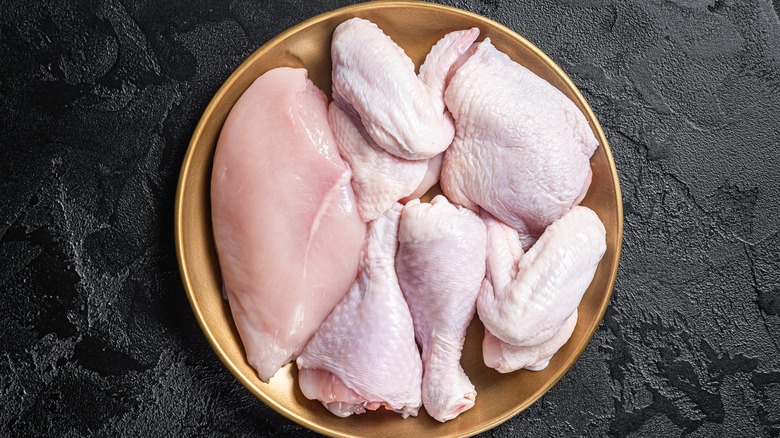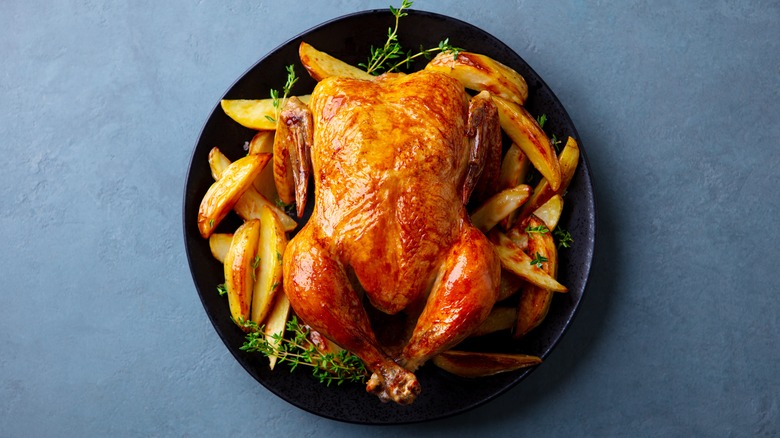Why Ina Garten Never Removes The Skin From Chicken Breasts
Ina Garten knows her way around a kitchen. The cook, author, and host of the iconic Food Network show "Barefoot Contessa" is one of the most trusted authorities on delicious recipes that are sure to satisfy. But her most treasured dishes are simple, such as her roast chicken. If you're a fan of Garten, there may be a few patterns you will catch onto; perhaps one of her most well-known is the proclivity for keeping the skin on her poultry, chicken breasts in particular.
While most chicken breasts found in the grocery store are sold without skin, Garten has a clear preference for skin-on options, and for a very good reason. According to a statement on her website, Garten finds that it "makes the meat much more tender and moist." That's because the skin helps to trap moisture in the meat while cooking, and since the breast is a particularly lean cut, it's more likely to dry out under heat, especially with no protective layer on top.
However, even if you're not a huge fan of chicken skin, you might still want to cook the meat with it on, as Garten suggests. This will help to trap the moisture, even if you ultimately choose to remove it after cooking. After all, who could turn down an infusion of flavor and moisture that is built right into the chicken?
Having a thick skin does well for chicken, too
It might be difficult to find a cut of chicken breast with skin in the prepackaged section of the grocery store. Instead, you will most likely have to visit your local butcher or ask the meat department at your grocery store to cut the piece for you from a whole chicken. Alternatively, you can buy a whole bird and break it down yourself. This will allow you to make several meals out of it, and give you the ability to cut it exactly to your liking — with the skin, or with skin and even bone if you prefer.
As Ina Garten reasons, a skin-on cut of breast is optimal because it helps to keep your chicken breast moist while cooking, and also helps to infuse flavor in the cooking process. Additionally, cooking with the skin on will produce a juicier interior and a perfectly crispy exterior, making a supremely delicious dish.
Cooking your chicken breasts with the bone in can also help to infuse your meat with more flavor, which comes from the bone's marrow as well as the fat that surrounds it. Nutrients from the bones also suffuse through the chicken while cooking, making the poultry even more nutritiously dense.
No skin in the game (or grocery store)
Skin-on chicken wasn't always difficult to come by, as it used to be widely available in grocery stores. Today, though, skinless, boneless varieties of chicken breast have become much more popular among consumers who find them easier to cook and who are looking for meat that contains less fat.The more wholesome chicken breast has essentially been pushed out of most grocery stores.
Skin-on chicken has gotten a bad rap thanks to its higher fat content, with many health-conscious cooks steering away from the cut to reduce their fat intake. After all, a 3-ounce breast cut of chicken is about 116 calories and has about 1.6 grams of fat, whereas a skin-on cut of chicken breast is 140 calories and has three grams of fat, nearly double that of a skinless breast. However, this doesn't mean that you need to remove the skin to cut its fat content. Instead, you can cook your chicken with the skin on and remove it after cooking so that you get all of the flavor benefits without the fat. The skin will help to keep your chicken more moist without the use of marinades, while also infusing it with the flavor inherent to chicken skin, which is key to many of Garten's recipes.


